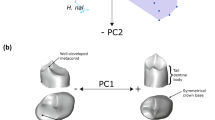Abstract
IN the course of quantitative evolutionary studies on the dentition of fissipede carnivores we1 have recently published a paper utilizing two angular measurements, α measuring the relation of protoconid height and talonid length in lower M1 and β the relation between total length and protocone height in upper P4. Graphic representation on Cartesian co-ordinates of the two values thus obtained for a number of species shows that the relative position of the values of α and β has an important biological significance, since it reveals the general phylogenetic tendencies of the group and its constituent sub-groups, and is in close agreement with the qualitative findings of taxonomy.
Similar content being viewed by others
References
Crusafont-Pairó, M., and Truyols-Santonja, J., Evolution, 10, 314 (1956).
Blanc, A. C., Riv. Antrop., Rome, 34, 179 (1943).
Huxley, J. S., Nature, 180, 454 (1957).
Author information
Authors and Affiliations
Rights and permissions
About this article
Cite this article
CRUSAFONT-PAIRÓ, M., TRUYOLS-SANTONJA, J. A Quantitative Study of Stasigenesis in Fissipede Carnivores. Nature 181, 289–290 (1958). https://doi.org/10.1038/181289a0
Issue Date:
DOI: https://doi.org/10.1038/181289a0
- Springer Nature Limited
This article is cited by
-
Ecological Adaptations of Mandibular Form in Fissiped Carnivora
Journal of Mammalian Evolution (2011)
-
Cats and Dogs Down the Tree: The Tempo and Mode of Evolution in the Lower Carnassial of Fossil and Living Carnivora
Evolutionary Biology (2010)





